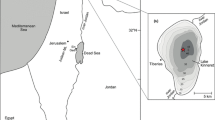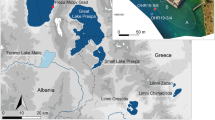Abstract
Late Quaternary environments have been studied by pollen analysis of lake sediments from the savannas of the Colombian Llanos Orientales at 180 m elevation. The pollen record form Laguna El Pinal (4°08′N, 70°23′W), dated by 6 AMS radiocarbon dates, starts at 18,290 14C yr B.P. The record from Laguna Carimagua (4°04′N, 70°14′W), also dated by 6 AMS dates, starts at 8270 14C yr B.P. Both records show a landscape dominated by grassland savanna with only few woody savanna taxa, such as Curatella and Byrsonima, frequent fires, and little occurrence of forest and/or gallery forest along the rivers. The savanna ecosystem at the studied sites was relatively stable during the last 18,000 yrs, but minor changes in floral composition, and in the proportion of savanna/forest, have been recorded. Very little gallery forest and the non permanent lake conditions of Laguna El Pinal reflect the driest period, interpreted to reflect low rainfall rates and long dry seasons during the Last Glacial Maximum until 10,690 14 C yr B.P. During the Late Glacial, Laguna El Pinal was a permanent shallow lake, and changed into a lake with higher water levels during the Holocene, indicating wetter conditions. Expansion of regional gallery forest also started at around 10,690 14C yr B.P. Little vegetational change observed in Laguna Carimagua at 5570 14 C yr B.P., in combination with a simultaneous decrease of savanna observed in previously studied lakes, suggest a change to regional wetter conditions. Thus, the Holocene before 5500 14 C yr B.P. was somewhat drier than the following period until about 3850 14C yr B.P. In both records, Late Holocene lake deposits are incomplete. Shore vegetation of Laguna Carimagua always included a minor contribution of the palms Mauritia and Mauritiella. The marked increase of palms during the last c. 3800 yrs points to increased human impact on the vegetation under the wettest Holocene climate regime.
Similar content being viewed by others
References
Behling, H., 1993. Untersuchungen zur spätpleistozänen und holozänen Vegetations-und Klimageschichte der tropischen Küstenwälder und der Araukarienwälder in Santa Catarina (Südbrasilien). Dissertationes Botanicae, 206: J. Cramer, Berlin Stuttgart, 149 pp.
Behling, H. & M. L. da Costa, 1997. Studies on Holocene tropical vegetation, mangrove and coast environments in the state of Maranhão, NE Brazil. Quat. S. Am. Antarctic Pen. 10: 93–118.
Behling, H. & H. Hooghiemstra, 1998. Late Quaternary paleoecology and paleoclimatology from pollen records of the savannas of the Llanos Orientales in Colombia. Palaeogeography, Palaeoclimatology, Palaeoecology 139: 251–267.
Blydenstein, J., 1967. Tropical savanna vegetation of the Llanos of Colombia. Ecology 48: 1–15.
Clapperton, C., 1993. Quaternary geology and geomorphology of South America. Elsevier, Amsterdam, 779 pp.
Cole, M. M., 1982. The influence of soils, geomorphology and geology on the distribution of plant communities in savanna ecosystems. In: Huntley, B. J. & B. H. Walker (eds), Ecology of Tropical Savannas. Ecological Studies, 42: 145–174. Springer, Berlin.
Cole, M. M., 1986. The savannas: biogeography and geobotany. Academic Press, London, 438 pp.
Cuatrecasas, J., 1989. Aspectos de la vegetación natural en Colombia. Perez-Arbelaezia, II (8), 155–283. Jardín Botánico de Bogotá 'Jose Celestino Mutis'.
Faegri, K. & J. Iversen, 1989. Textbook of pollen analysis. (4th ed.); John Wiley & Sons, Chichester, 328 pp.
Furley, P. A., 1992. Edaphic changes at the forest-savanna boundary with particular reference to the neotropics. In: Furley, P. A. et al. (eds), Nature and Dynamics of Forest-Savanna Boundaries. Chapman & Hall, London, 91–117.
Furley, P. A., Proctor, J. & J. A. Ratter, (eds), 1992. Nature and Dynamics of Forest-Savanna Boundaries. Chapman & Hall, London, 616 pp.
Gentry, A. H., 1993. Woody plants of northwest South America. Conservation International, Washington, DC, 895 pp.
Grimm, E. C., 1987. CONISS: A Fortran 77 program for stratigraphically constrained cluster analysis by the method of the incremental sum of squares. Computers and Geosciences 13: 13–35.
Henderson, A., 1995. The palms of the Amazon, Oxford University Press, New York, 362 pp.
Herrera, L. F. & L. E. Urrego, 1996. Atlas de polen de plantas útiles y cultivadas de la Amazonia colombiana (Pollen atlas of useful and cultivated plants in the Colombian Amazon region). Estudios en la Amazonia Colombiana, XI: 462 pp. Tropenbos-Colombia, Bogotá (also published in 'The Quaternary of Colombia', 24 (ed. H. Hooghiemstra), Amsterdam).
Hooghiemstra, H., 1984. Vegetational and climatic history of the high plain of Bogotá, Colombia: a continuous record of the last 3,5 million years. Dissertationes Botanicae, J. Cramer, Vaduz 79: 368 pp.
Huber, O. 1987. Neotropical savannas: their flora and vegetation. Tree 2: 67–71.
Hueck, K. & P. Seibert, 1972. Vergetationskarte von Südamerika. Fischer, Stuttgart, 71 pp + map.
Hueck, K., 1966. Die Wälder Südamerikas. Fischer, Stuttgart, 422 pp.
Kahn F. 1987. The distribution of palms as a function of local topography in Amazonian terra-firme forests. Experientia 43: 251–259.
Kahn, F. & J.-J., de Granville, 1992. Palms in forest ecosystems of Amazonia. Springer, Berlin, 226 pp.
Maas, P. J. M. & L. Y. T. Westra, 1993. Neotropical plant families. A concise guide to families of vascular plants in the Neotropics. Koeltz Scientific Books, Koenigstein, Germany, 289 pp.
Markgraf, V., 1993. Climatic history of Central and South America since 18,000 yr B.P: Comparison of pollen records and model simulations. In: Wright, H. E. Jr., Kutzbach, J. E., Webb III, T. Ruddiman, W. F., Street-Perrott, F. A. & P. J. Bartlein (eds). Global Climates Since the Last Glacial Maximum. University of Minnesota Press, Minneapolis Londen, 357–385.
Medina, E. & J. F. Silva, 1990. Savannas of northern South America: a steady state regulated by water-fire interactions on a background of low nutrient availability. J Biogeogr 17: 403–413.
Pinto-Escobar, P., 1993. Vegetación y flora de Colombia. Editora Guadalupe, Bogotá, 72 pp.
Ross, S. M., Luizao, F. J. & R. C. C. Luizao, 1992. Soil conditions and soil biology in different habitats across a forest-savanna boundary on Maraca Island, Roraima, Brazil. In: Furley, P. A. et al. (eds), Nature and Dynamics of Forest-Savanna Boundaries. Chapman & Hall, London, 145–170.
Roubik, D. W. & J. E. Moreno, 1991. Pollen and spores of Barro Colorado Island. Missouri Botanical Garden, 36, 270 pp.
Rull, V., 1991. Contribución a la paleoecologia de Pantepui la Gran Sabana (Guayana Venezolana): clima, biogeografía, y ecología. Scientia Guaianae, 2: 1–333.
Rull, V., 1992. Successional patterns of the Gran Sabana (southeastern Venezuela) vegetation during the last 5000 yrs, and its responses to climatic fluctuations and fire. J. Biogeogr. 19: 329–338.
Sarmiento, G. & M. Monasterio, 1975. A critical consideration of the environmental conditions associated with the occurrence of savanna ecosystems in tropical America. In: Golley, F. B. & E. Medina (eds), Tropical Ecological Systems; Trends in Terrestrial and Aquatic Research. Springer, Berlin, 223–250.
Sarmiento, G., 1983. The savannas in tropical America. In: Bourlière, F. (ed), Tropical Savannas. Elsevier, Amsterdam, 245–288.
Schubert, C. 1988. Climatic changes during the Last Glacial Maximum in northern South America and Caribbean: a review. Interciencia 13: 128–137.
Snow, J. W., 1976. The climate of northern South America. In: Schwerdtfeger, W. (ed.), World Survey of Climatiology, 12. Climates of Central and South America. Elsevier, Amsterdam, 295–403.
Tissot, C. & C. Marius, 1992. Holocene evolution of the mangrove ecosystem in French Guiana: a palynological study. In: Singh, K. P. & J. S. Singh (eds), Tropical Ecosystems: Ecology and Management. Wiley Eastern Limited, New Delhi, 333–347.
Van der Borg, K., Alderliesten, A., Harnton, C. M., De Jong, A. F. & N. A. Van Zwol, 1987. Accelerator mass spectrometry with 14C and 10Be in Utrecht. Nuclear Instrumental Methods B 29: 143–145.
Van der Hammen, T., 1963. A palynological study on the Quaternary of British Guyana. Leidse Geologische Mededelingen 29: 126–168.
Vareschi, V., 1980. Vegetationsökologie der Tropen. Ulmer, Stuttgart, 293 pp.
Wijmstra, T. A., 1971. The palynology of the Guiana coastal basin. Ph.D. Dissertation, University of Amsterdam, 63 pp.
Wijmstra, T. A. & T. Van der Hammen, 1966. Palynological data on the history of tropical savannas in northern South America. Leidse Geologische Mededelingen 38: 71–90.
Author information
Authors and Affiliations
Rights and permissions
About this article
Cite this article
Behling, H., Hooghiemstra, H. Environmental history of the Colombian savannas of the Llanos Orientales since the Last Glacial Maximum from lake records El Pinal and Carimagua. Journal of Paleolimnology 21, 461–476 (1999). https://doi.org/10.1023/A:1008051720473
Issue Date:
DOI: https://doi.org/10.1023/A:1008051720473




